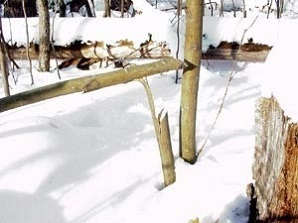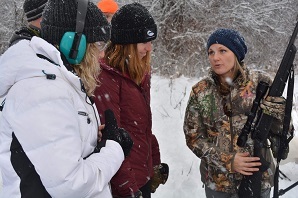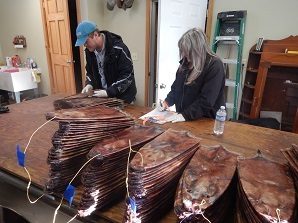Enhance Deer Habitat As days are getting longer and spring approaches, now is a great time for habitat management projects that involve cutting trees to provide new food and cover for deer and other wildlife. Felling trees for firewood or forest thinning makes the tops immediately available to deer. Later, stump sprouts and new plant growth caused by gaps in the tree canopy will provide additional food and cover for deer. Late winter, while trees are still dormant, is also the ideal time to prune fruit trees and to open the canopy around them to maximize their growth and fruiting potential.  Hinge-cuts are also a popular method of enhancing deer habitat and can often be accomplished with just a handsaw. Hinge-cutting involves cutting two-thirds through a small tree and pushing it over so that the uncut portion remains attached. This method allows the tree to stay alive, but the top and the new growth are within deer's reach. Hinge-cutting can also be used strategically to improve bedding and fawning cover or create natural screening for woodland openings and food plots. Hinge-cuts are also a popular method of enhancing deer habitat and can often be accomplished with just a handsaw. Hinge-cutting involves cutting two-thirds through a small tree and pushing it over so that the uncut portion remains attached. This method allows the tree to stay alive, but the top and the new growth are within deer's reach. Hinge-cutting can also be used strategically to improve bedding and fawning cover or create natural screening for woodland openings and food plots.
To maximize benefit and preserve future timber value, learn to identify preferred winter deer foods and consult a forester or biologist for guidance. Quality habitat improves deer survival and productivity and boosts body and antler size, setting the stage so you can "let young bucks go and watch them grow!"
Hunter Education Classes Available Before Spring Turkey Season  All first-time hunters planning to go afield this upcoming spring turkey season must first complete a mandatory hunter education course before they can purchase a hunting license. In-person, instructor-led hunter education courses are being offered throughout NYS during March and April. Classes fill quickly, so do not delay in registering for a course. All classes are free of charge. To locate a hunter education class near you, visit DEC's website. All first-time hunters planning to go afield this upcoming spring turkey season must first complete a mandatory hunter education course before they can purchase a hunting license. In-person, instructor-led hunter education courses are being offered throughout NYS during March and April. Classes fill quickly, so do not delay in registering for a course. All classes are free of charge. To locate a hunter education class near you, visit DEC's website.
Muskrat Aging  Once the "bread and butter" of the fur harvest in NY, muskrat populations have declined from their peak in the 1950s to the 1970s. This year, our furbearer biologists are collecting age and sex information to determine muskrat recruitment rates. By attending wild fur auctions and visiting individual trappers and fur buyers, biologists examine thousands of prepared muskrat pelts. Unique patterns on the pelts indicate the age of the muskrat. Sex can also be determined by close examination. Once the "bread and butter" of the fur harvest in NY, muskrat populations have declined from their peak in the 1950s to the 1970s. This year, our furbearer biologists are collecting age and sex information to determine muskrat recruitment rates. By attending wild fur auctions and visiting individual trappers and fur buyers, biologists examine thousands of prepared muskrat pelts. Unique patterns on the pelts indicate the age of the muskrat. Sex can also be determined by close examination.
|  Hinge-cuts
Hinge-cuts All first-time hunters planning to go afield this upcoming spring turkey season must first complete a mandatory hunter education course before they can purchase a hunting license. In-person, instructor-led hunter education courses are being offered throughout NYS during March and April. Classes fill quickly, so do not delay in registering for a course. All classes are free of charge. To locate a hunter education class near you,
All first-time hunters planning to go afield this upcoming spring turkey season must first complete a mandatory hunter education course before they can purchase a hunting license. In-person, instructor-led hunter education courses are being offered throughout NYS during March and April. Classes fill quickly, so do not delay in registering for a course. All classes are free of charge. To locate a hunter education class near you,  Once the "bread and butter" of the fur harvest in NY, muskrat populations have declined from their peak in the 1950s to the 1970s. This year, our furbearer biologists are collecting age and sex information to determine muskrat recruitment rates. By attending wild fur auctions and visiting individual trappers and fur buyers, biologists examine thousands of prepared muskrat pelts. Unique patterns on the pelts indicate the age of the muskrat. Sex can also be determined by close examination.
Once the "bread and butter" of the fur harvest in NY, muskrat populations have declined from their peak in the 1950s to the 1970s. This year, our furbearer biologists are collecting age and sex information to determine muskrat recruitment rates. By attending wild fur auctions and visiting individual trappers and fur buyers, biologists examine thousands of prepared muskrat pelts. Unique patterns on the pelts indicate the age of the muskrat. Sex can also be determined by close examination.
No comments:
Post a Comment